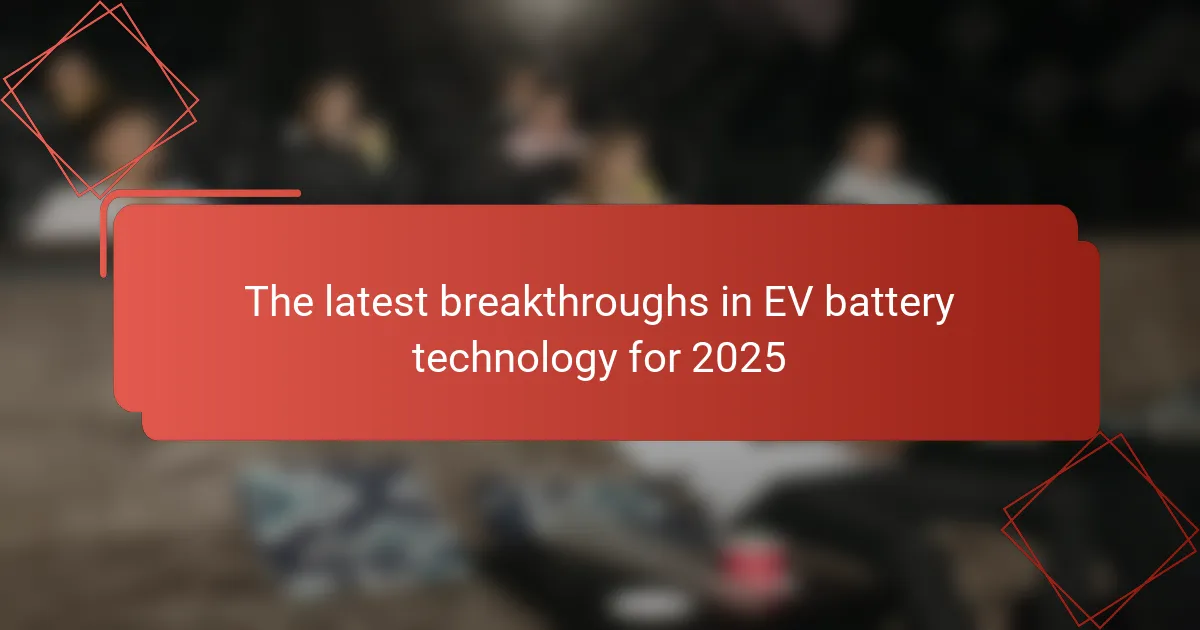The latest breakthroughs in electric vehicle (EV) battery technology for 2025 are poised to transform the industry by enhancing performance, safety, and sustainability. Key innovations, including solid-state batteries and fast-charging technologies, promise to improve energy density and reduce charging times, making EVs more appealing to consumers. Additionally, advancements in recycling methods will support a more sustainable lifecycle for these batteries, further promoting the adoption of electric vehicles.
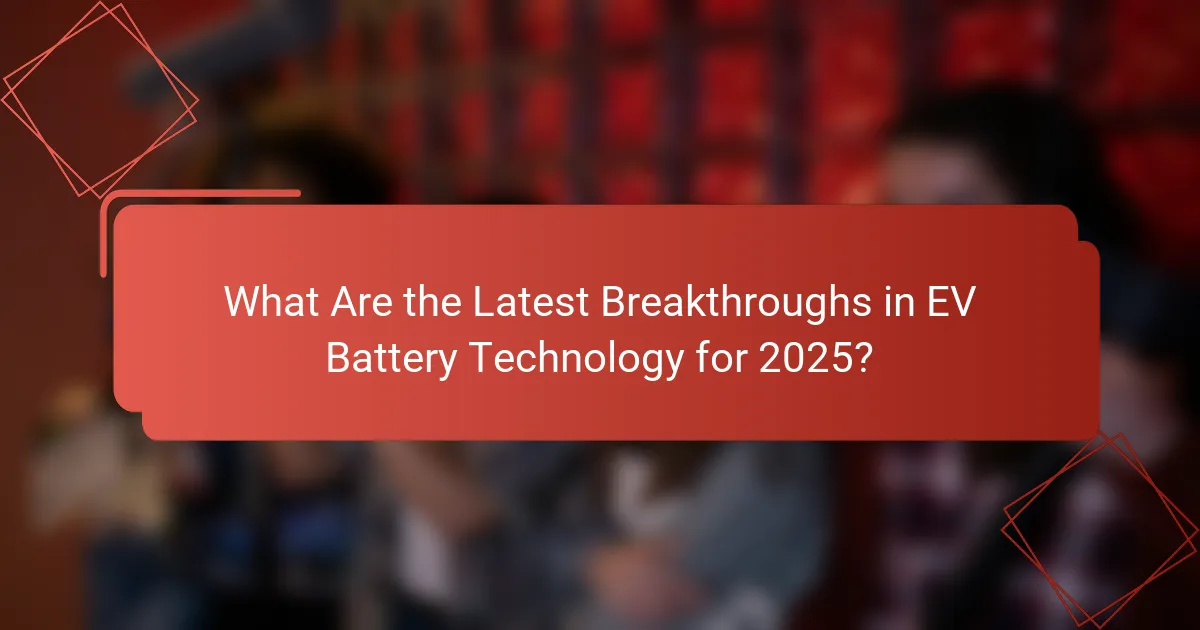
What Are the Latest Breakthroughs in EV Battery Technology for 2025?
The latest breakthroughs in electric vehicle (EV) battery technology for 2025 focus on enhancing performance, safety, and sustainability. Innovations such as solid-state batteries, fast-charging technologies, and improved recycling methods are set to revolutionize the EV market.
Solid-state batteries
Solid-state batteries represent a significant advancement in EV battery technology, replacing liquid electrolytes with solid materials. This change enhances safety by reducing the risk of leaks and fires, while also improving energy density, which can lead to longer driving ranges.
Manufacturers are exploring various solid materials, including ceramics and polymers, to optimize performance. Although still in the development phase, these batteries are expected to become commercially viable by 2025, with prototypes already showing promising results.
Fast-charging technologies
Fast-charging technologies are evolving to significantly reduce the time it takes to recharge EV batteries. New charging stations are being developed that can deliver power at rates exceeding 350 kW, allowing for a full charge in under 30 minutes.
Additionally, advancements in battery chemistry are enabling batteries to accept higher charging currents without overheating. This means that drivers can expect more convenient charging options, particularly in urban areas where quick stops are essential.
Recycling advancements
Recycling advancements are crucial for sustainable EV battery production, as they aim to recover valuable materials like lithium, cobalt, and nickel. Innovative processes are being developed to efficiently extract these materials from used batteries, reducing the need for new mining operations.
By 2025, regulations may require manufacturers to implement recycling programs, ensuring that a significant percentage of battery materials are reused. This not only minimizes environmental impact but also helps stabilize supply chains for critical battery components.
Battery management systems
Battery management systems (BMS) are becoming increasingly sophisticated, enhancing the performance and lifespan of EV batteries. These systems monitor battery health, temperature, and charge levels, optimizing charging cycles and preventing overcharging.
Advanced BMS can also integrate with vehicle software to provide real-time data to drivers, helping them manage their energy consumption more effectively. As these systems improve, they will contribute to greater efficiency and reliability in EV performance.
Energy density improvements
Energy density improvements are a key focus in EV battery development, aiming to increase the amount of energy stored per unit weight. Higher energy density translates to longer ranges and lighter batteries, which are essential for enhancing vehicle performance.
Research is ongoing into new materials and battery architectures that can achieve energy densities of over 300 Wh/kg. These improvements will likely make EVs more competitive with traditional vehicles, appealing to a broader range of consumers by 2025.
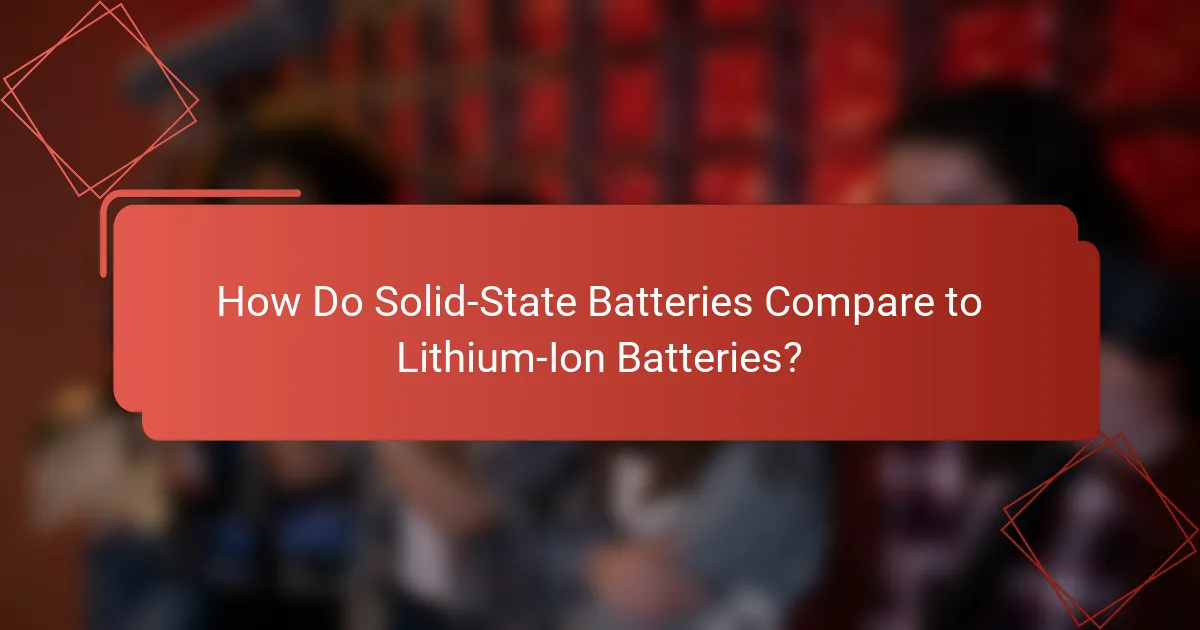
How Do Solid-State Batteries Compare to Lithium-Ion Batteries?
Solid-state batteries offer significant advantages over traditional lithium-ion batteries, particularly in energy density, safety, and lifespan. These advancements position solid-state technology as a promising solution for electric vehicles (EVs) by 2025.
Higher energy density
Solid-state batteries can achieve energy densities that are often 30-50% higher than those of conventional lithium-ion batteries. This increased energy density allows for longer driving ranges on a single charge, which is crucial for EV adoption. For instance, while lithium-ion batteries may provide around 250-300 Wh/kg, solid-state options could reach 400 Wh/kg or more.
Higher energy density translates to lighter battery packs, which can enhance vehicle performance and efficiency. This is particularly beneficial for electric vehicles, where weight reduction can lead to improved acceleration and handling.
Improved safety
Safety is a critical concern for battery technology, and solid-state batteries are generally considered safer than lithium-ion counterparts. They utilize a solid electrolyte instead of a liquid one, reducing the risk of leaks and fires. This solid structure minimizes the chances of dendrite formation, which can cause short circuits in lithium-ion batteries.
Additionally, solid-state batteries can operate at higher temperatures without compromising safety, making them suitable for various climates and driving conditions. This reliability can enhance consumer confidence in electric vehicles.
Longer lifespan
Solid-state batteries typically exhibit a longer lifespan compared to lithium-ion batteries, often lasting 2-3 times longer. This longevity is due to their stable chemical structure, which reduces degradation over time. Users can expect fewer replacements and lower maintenance costs, making solid-state technology more economical in the long run.
Moreover, the extended lifespan of solid-state batteries contributes to sustainability efforts by reducing waste and the need for raw material extraction. As manufacturers scale production, the environmental impact of battery disposal can be significantly mitigated.
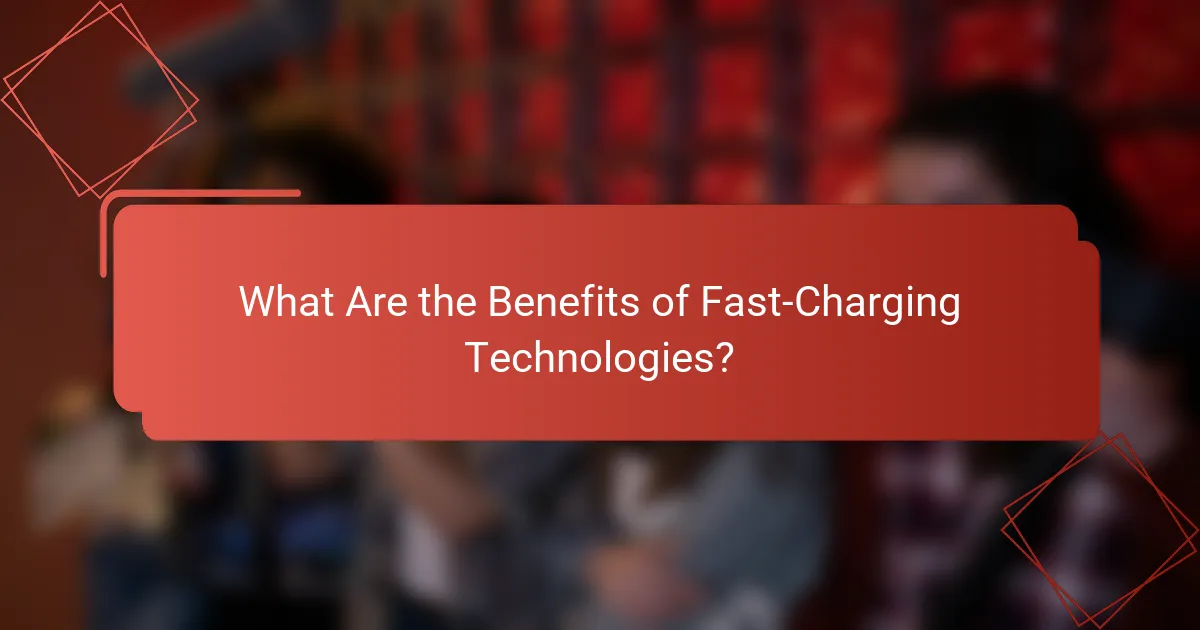
What Are the Benefits of Fast-Charging Technologies?
Fast-charging technologies significantly reduce the time needed to recharge electric vehicle (EV) batteries, enhancing the overall user experience. These advancements not only improve convenience but also encourage more drivers to adopt electric vehicles, contributing to a greener environment.
Reduced charging time
Fast-charging technologies can cut charging times to as little as 15-30 minutes for a substantial battery charge, compared to several hours with standard chargers. This is achieved through higher power levels, often exceeding 150 kW, which allows for rapid energy transfer to the battery. However, it’s essential to ensure that the EV’s battery management system is compatible with these high charging rates to avoid damage.
Enhanced user convenience
With reduced charging times, users can enjoy the convenience of charging their vehicles during short stops, such as at a coffee shop or while running errands. This flexibility makes owning an EV more practical, as drivers can quickly top off their batteries without significant disruptions to their daily routines. Additionally, many fast chargers are strategically located along highways, making long-distance travel more feasible.
Increased adoption rates
The convenience of fast-charging technologies is a key factor in increasing EV adoption rates. As charging infrastructure expands and becomes more accessible, potential buyers are more likely to consider electric vehicles as a viable option. Governments and private sectors are investing in fast-charging networks, which further supports this trend and helps alleviate range anxiety among consumers.
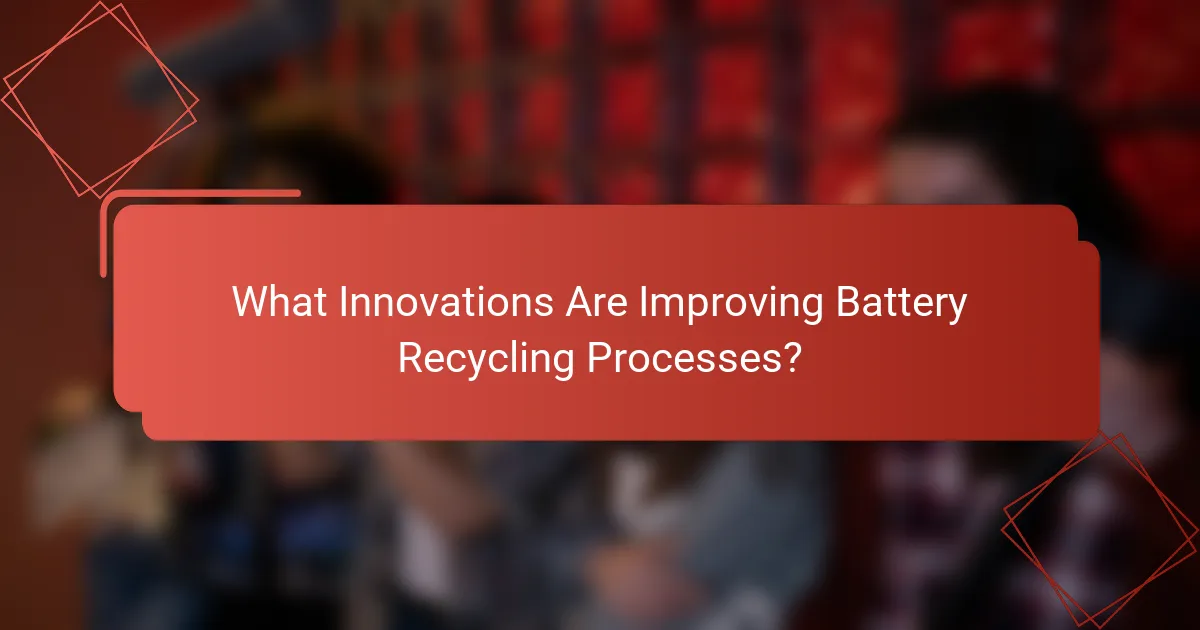
What Innovations Are Improving Battery Recycling Processes?
Innovations in battery recycling processes are enhancing efficiency and sustainability, crucial for the growing electric vehicle (EV) market. These advancements focus on minimizing waste and recovering valuable materials from used batteries.
Closed-loop recycling systems
Closed-loop recycling systems allow manufacturers to reclaim materials from used batteries and reintegrate them into new battery production. This process reduces the need for raw material extraction, which can be environmentally damaging and costly.
For example, lithium-ion batteries can be processed to recover lithium, cobalt, and nickel, which are essential for new battery manufacturing. By implementing closed-loop systems, companies can significantly lower production costs and their carbon footprint.
Advanced separation techniques
Advanced separation techniques utilize innovative methods to efficiently extract valuable components from spent batteries. Techniques such as hydrometallurgy and pyrometallurgy are becoming more prevalent, allowing for higher recovery rates of critical materials.
These methods involve chemical processes that dissolve battery materials or high-temperature treatments that separate metals. As these technologies improve, they can achieve recovery rates exceeding 90% for certain materials, making recycling more economically viable.
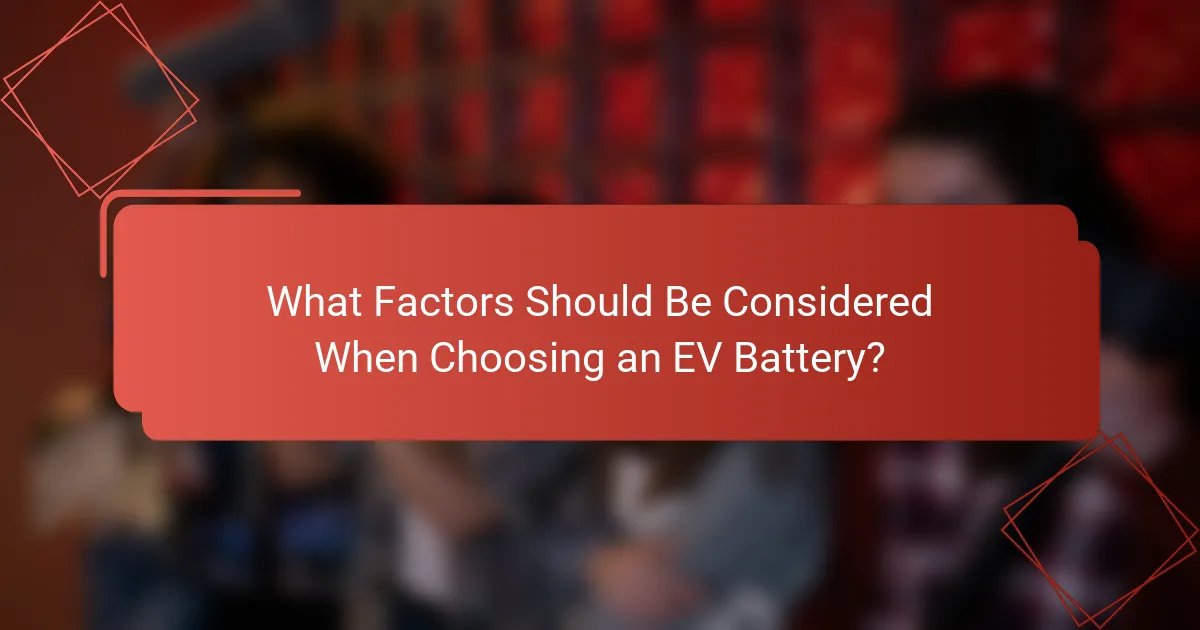
What Factors Should Be Considered When Choosing an EV Battery?
When selecting an EV battery, key factors include energy capacity, charging speed, lifespan, and cost. Each of these elements significantly impacts the vehicle’s performance, range, and overall ownership experience.
Energy capacity
Energy capacity refers to the total amount of energy a battery can store, typically measured in kilowatt-hours (kWh). A higher capacity allows for longer driving ranges between charges, which is crucial for daily commuting and long trips.
When evaluating energy capacity, consider your driving habits. For instance, urban drivers may find a battery with 40-60 kWh sufficient, while those frequently traveling longer distances might prefer capacities of 70 kWh or more. Balancing capacity with vehicle weight and cost is essential for optimal performance.
Additionally, keep in mind that energy capacity can influence charging time. Batteries with larger capacities may take longer to charge, so assess your charging options and availability to ensure they align with your needs.
